
Arkanoid is a 1986 block breaker arcade game developed and published by Taito. In North America, it was published by Romstar. Controlling a paddle-like craft known as the Vaus, the player is tasked with clearing a formation of colorful blocks by deflecting a ball towards it without letting the ball leave the bottom edge of the playfield. Some blocks contain power-ups that have various effects, such as increasing the length of the Vaus, creating several additional balls, or equipping the Vaus with cannons. Other blocks may be indestructible or require multiple hits to break.
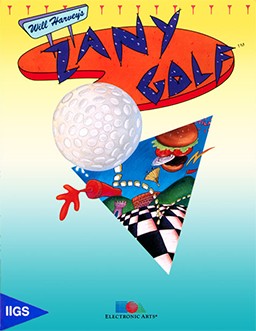
Zany Golf, also known as Will Harvey's Zany Golf, is a fantasy take on miniature golf developed by Sandcastle Productions and published by Electronic Arts in 1988. The game was originally written for the Apple IIGS and subsequently ported to the Amiga, Atari ST, and MS-DOS compatible operating systems. In 1990, a port was released for the Sega Genesis. The game was developed by Will Harvey, Ian Gooding, Jim Nitchals, and Douglas Fulton. Harvey was pursuing his advanced degrees at Stanford University at the time.

Breakout is an arcade video game developed and published by Atari, Inc. and released on May 13, 1976. It was designed by Steve Wozniak, based on conceptualization from Nolan Bushnell and Steve Bristow, who were influenced by the seminal 1972 Atari arcade game Pong. In Breakout, a layer of bricks lines the top third of the screen and the goal is to destroy them all by repeatedly bouncing a ball off a paddle into them. The arcade game was released in Japan by Namco. Breakout was a worldwide commercial success, among the top five highest-grossing arcade video games of 1976 in both the United States and Japan and then among the top three highest-grossing arcade video games of 1977 in the US and Japan. The 1978 Atari VCS port uses color graphics instead of a monochrome screen with colored overlay.
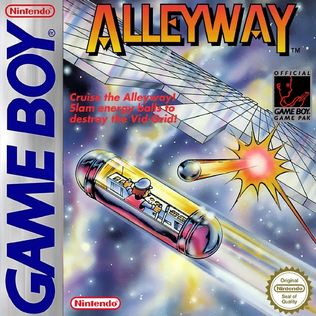
Alleyway is a 1989 video game developed by Nintendo and Intelligent Systems and published by Nintendo as a global launch title for the Game Boy. It is a Breakout clone and one of the first four games developed and released for the system. The game was released first in Japan in 1989, in North America later that year, and in Europe in 1990. It was later re-released for the Nintendo 3DS Virtual Console in June 2011, and on the Nintendo Switch Online service in May 2024.

Klax is a puzzle video game released in arcades in 1990 by Atari Games while Namco distributed the game in Japanese markets. It was designed and animated by Mark Stephen Pierce with the software engineering done by Dave Akers. The object is to catch colored blocks tumbling down a machine and arrange them in colored rows and patterns to make them disappear. Klax was originally published as a coin-op follow-up to Tetris, about which Atari Games was in a legal dispute at the time.

Pinball is a pinball video game developed by Nintendo and HAL Laboratory and published by Nintendo for the Nintendo Entertainment System. It is based on a Game & Watch unit of the same name, and was first released for the Famicom in Japan in 1984. It was later released as an arcade game for the Nintendo VS. System in Japan and North America in 1984. In 1985, it was a launch game for the Nintendo Entertainment System in North America.
Super DX-Ball is a shareware game by BlitWise Productions, released on November 10, 2004. It is an enhanced remake to the classic brick-buster hit DX-Ball. Among new features since previous games, Super DX-Ball introduces refined, classic-style graphics and a new dimension of bricks with various shapes and sizes, adding a unique gameplay experience in a Breakout-style game.

Kirby’s Block Ball, known in Japan as Kirby no Block Ball, is a 1995 video game developed by Tose and Nintendo and published by Nintendo for the Game Boy portable console. It is a spin-off of the Kirby video game series. It is a Breakout clone; the player controls paddles along the screen's edge to knock a bouncing ball, Kirby, into destructible bricks. The game's 55 levels include power-ups, bonus rounds, and minigames. The team spent half a year revising the gameplay to match Kirby's signature characteristics. Kirby's Block Ball was released in Japan on December 14, 1995, later in North America on May 13, 1996 and finally in Europe on August 29, 1996.

Arkanoid: Revenge of Doh is an arcade game released by Taito in 1987 as a sequel to Arkanoid.
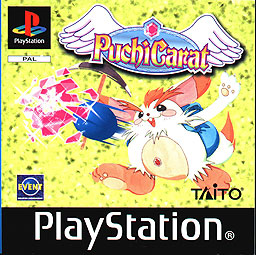
Puchi Carat is a 1997 video game by Taito.
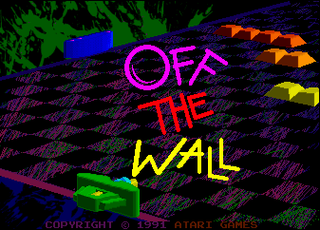
Off the Wall is an arcade game produced by Atari Games and released in North America in 1991. A remake of Breakout, it has a much wider variety of gameplay elements of the original. Most notably, it models spin on the ball. Off the Wall supports up to three players simultaneously. The game's graphics include many backgrounds modeled after modern abstract art. In spite of the identical title, this is a different game from the 1989 Atari 2600 cartridge release.

Superball Arcade is am Arkanoid-like video game for Microsoft Windows released as shareware on May 29, 2003 by Canadian developer Cheeky Monkey Software. It is a sequel to the 2002 game Atomic Superball: The Chicken Edition.
Krypton Egg is a block breaker game developed in 1989 by Alexandre Kral on Atari ST and Amiga 500/600 (OCS/ECS).

Arkanoid DS is a breakout video game developed by Taito and published by Square Enix for the Nintendo DS. It was released on December 6, 2007.

Break 'Em All, known as Brick 'Em All DS in Europe, is an Arkanoid clone released in 2005 for the Nintendo DS. The game features several single-player modes, as well as single-cart multiplayer for up to 8 players. The game utilized the system's touch screen to control the paddle, as well as activate power-ups. Power-Ups could also be activated by pressing up on the D-Pad or by pressing the X Button.
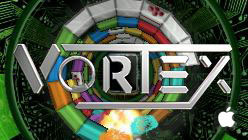
Vortex is an iPod game created by Apple Inc. and Kabloom Games. It is an Arkanoid/Breakout clone with a top-down perspective and bricks arranged in a circular layout controlled by a click wheel

Shatter is an action video game developed and published by Sidhe Interactive. The game was released on July 23, 2009 for PlayStation 3 via PlayStation Network, on March 15, 2010 for Microsoft Windows, on September 18, 2012 for OS X, and on March 14, 2013 for Linux. A remastered version developed by Sidhe's successor PikPok and published by Netflix was released for iOS and Android via Netflix Games on March 23, 2022. A version of the mobile remaster published by PikPok, subtitled Remastered Deluxe, was released on November 2, 2022 for Windows, Nintendo Switch, PlayStation 4, PlayStation 5, Xbox One, and Xbox Series X/S.
Rival Ball is the sequel to the PC Breakout clone DX-Ball 2 from Longbow Digital Arts. Released on March 19, 2001, the game features square bricks and online split-screen multiplayer. It introduces a cursor-based layout with buttons for navigation, two new power-ups, the ability to save and resume games, and game options for randomising board order, setting timers, repeating board-sets, and choosing between four difficulty levels. The game also plays all the original DX-Ball 2 boards. A Mac version was announced on April 3, 2002. Rival Ball was the first game from Longbow Games to succeed the passing of Seumas McNally (1979–2000), the company's founder and lead programmer. Rival Ball was followed by Rival Ball Tournament in 2004.

Quester is a 1987 block breaker arcade game developed and published in Japan by Namco. Controlling a paddle-like craft, the player is tasked with clearing each stage by deflecting a ball towards a formation of bricks towards the top of the screen. Power-up items are hidden in some blocks, which can increase the size of the player's paddle, a barrier that prevents the ball from moving off the screen, and a forcefield that will release eight other balls when touched.
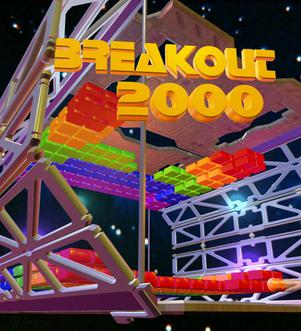
Breakout 2000 is a 1996 action video game developed by MP Games and published by Telegames for the Atari Jaguar. Part of the 2000 series by Atari Corporation, it is a remake of the arcade game Breakout (1976), and one of the last officially licensed releases for the platform. Featuring a similar premise to Breakout, the player must destroy a layer of brick lines by repeatedly bouncing a ball spawned off a paddle into them and keep it in play. Gameplay modifications to the original game include a third-person perspective behind the paddle in a pseudo-3D playfield, power-ups, bonus levels, enemies, varying level designs, and multiplayer features.















